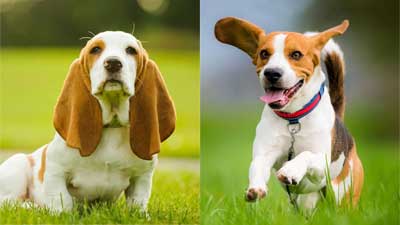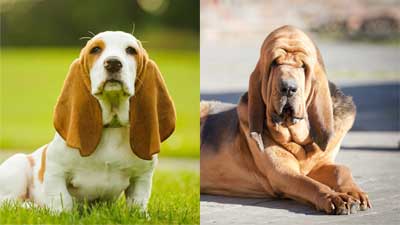- Size
- Smallest
- Small
- Small to Medium
- Medium
- Large
- Giant
- Characteristics
- Smartest
- Hypoallergenic
- Fluffy
- Best Guard
- Best Family
- Best for Kids
- Low Shedding
- Healthiest
- Police Dogs
- Most Calm
- Quietest
- Color
- White
- Black
- Grey
- Brown
- Blue
- Red
- Coat
- Hairless
- Short
- Long
- Origin
- Japan
- China
- Australia
- Germany
- Italy
- United States
- France
- Group
- Hound
- Terrier
- Herding
- Toy
- Working
- Sporting
Droopy Ears vs. Upright Ears in Dogs: What's the Difference?

The world of dogs is rich and diverse, with over 340 recognized dog breeds worldwide. One of the most striking physical characteristics that varies among different breeds is the shape of their ears. Some dogs have droopy, floppy ears that hang down, while others boast upright, pointy ears that stand tall. The differences in ear shape not only provide unique aesthetic appeal but also serve functional purposes and reflect the evolutionary history of each breed.
In this article, we will delve into the intriguing world of droopy and upright ears, exploring their characteristics, functions, and the evolutionary factors that led to their development.
The Evolutionary of Ear Shapes
Adaptive Advantages in the Wild:
The divergence between droopy and upright ears in different breeds can be traced back to the evolutionary history of dogs. In the wild, canids relied on their senses for survival, and ear shape played a role in enhancing these sensory abilities. Droopy ears in certain breeds may have provided advantages in scent tracking, while upright ears could have facilitated precise sound localization, aiding in hunting and communication within the pack.
Human Influence and Selective Breeding:
As dogs became companions to humans, the influence of selective breeding became a powerful force shaping the physical characteristics of various breeds. The intentional selection of dogs with specific ear shapes led to the perpetuation of these traits, whether for functional advantages or aesthetic preferences. Human-guided evolution has played a pivotal role in creating the diverse spectrum of ear shapes we observe in modern dog breeds.
Droopy Ears
Droopy ears, also known as pendants or floppy ears, create an enchanting and endearing silhouette that graces various dog breeds. Breeds like the Basset Hound, Bloodhound, and Cocker Spaniel showcase the iconic elegance of droopy ears. This distinctive feature adds a touch of charm to these breeds, contributing to their appeal and creating a lasting impression on dog enthusiasts around the world.
Genetic Foundations:
The genetic blueprint of droopy ears involves specific genes that influence the development of cartilage, connective tissues, and muscles within the ear structure. Dominant or recessive genetic traits determine whether a dog will inherit the characteristic droopiness. Selective breeding practices, guided by breed standards and preferences, have played a crucial role in perpetuating this feature within certain lineages.
Functional Aspects:
Beyond their aesthetic allure, droopy ears often serve functional purposes rooted in the historical roles of specific breeds. Dogs with droopy ears, such as those bred for scent tracking like the Basset Hound and Bloodhound, benefit from the ear's design, which helps capture and channel scents toward the nose. Additionally, droopy ears can act as a protective barrier, preventing debris and dirt from entering the ear canal.
Common Breeds with Droopy Ears:
1. Basset Hound: The Basset Hound, with its soulful expression and long, droopy ears, epitomizes the iconic elegance of breeds with droopy ears. Bred for scent tracking, the Basset Hound's ears play a functional role in capturing and guiding scents toward the highly sensitive nose, showcasing the harmonious blend of form and function.
2. Bloodhound: Renowned for its exceptional olfactory abilities, the Bloodhound boasts long and pendulous ears that enhance its tracking capabilities. The droopy ears of the Bloodhound contribute to its distinctive appearance and highlight the breed's historical roles as skilled scent trackers.
3. Cocker Spaniel: The Cocker Spaniel, known for its friendly disposition and beautiful coat, showcases slightly feathered and gracefully drooping ears. While not as pendulous as some other breeds, the Cocker Spaniel's ears add to its overall charm and elegance, reflecting the breed's history as a hunting companion.
Upright Ears
Upright ears, also known as erect or prick ears, stand tall and proud, projecting an image of alertness and attentiveness. Breeds like the German Shepherd, Doberman Pinscher, and Siberian Husky exemplify the regal majesty of upright ears. This ear type is often associated with breeds that historically served roles requiring heightened responsiveness, agility, and precision.
Genetic Influences
The genetics of upright ears involve specific genes that govern the growth and positioning of cartilage and muscles in the ear structure. In some breeds, the trait of upright ears may be dominant, ensuring the consistent expression of this feature across generations. Selective breeding has further refined and accentuated the upright stance, aligning with the breed standards and intended roles.
Functional Advantages
Upright ears offer functional advantages, particularly in breeds where precise communication and responsiveness are crucial. The erect posture of these ears allows dogs to precisely detect and locate sounds in their environment, providing them with a heightened ability to respond to auditory cues. Breeds with upright ears are often associated with roles such as guarding, herding, and hunting.
Common Breeds with Upright Ears:
1. German Shepherd: The German Shepherd, a versatile and intelligent breed, is renowned for its upright ears that convey an air of regality and alertness. The breed's upright ears enhance its auditory acuity, aligning with its historical roles in herding and guarding.
2. Doberman Pinscher: The Doberman Pinscher, known for its sleek and powerful appearance, features ears that stand erect, adding to its overall elegance. The upright ears of the Doberman contribute to its vigilant and attentive demeanor, making it an ideal guard and protection dog.
3. Siberian Husky: The Siberian Husky, with its striking appearance and upright ears, embodies the beauty of cold-weather breeds. Upright ears facilitate precise sound localization, aligning with the breed's history as a sled dog in Arctic regions.
Health Considerations
Common Issues with Droopy Ears:
While droopy ears add character and charm, they can be prone to certain health issues. The design of droopy ears traps moisture within the ear canal, creating an environment conducive to wax buildup and bacterial growth. Regular cleaning and monitoring are crucial to prevent ear infections and discomfort.
Common Issues with Upright Ears:
Upright ears, while offering advantages in reduced susceptibility to ear infections, present a different set of considerations. The exposed ear canal increases the risk of injuries from foreign objects during playtime. Owners of dogs with upright ears should be attentive to signs of discomfort and inspect the ears regularly.
Care for Every Ear Shape
Effective Cleaning for Droopy Ears:
Cleaning your dog's ears, especially if they have droopy ears, is an essential part of regular grooming. Use a veterinarian-formulated ear cleanser and a clean cotton ball. Gently lift the ear flap and pour a small amount of cleanser into the ear canal. Massage the base of the ear to ensure the cleanser reaches all grooves, and use a cotton ball to absorb any excess solution or earwax.
Effective Cleaning for Upright Ears:
For dogs with upright ears, the cleaning process may be more straightforward due to the exposed ear canal. Use a clean cotton ball or cotton pad soaked in a dog-friendly ear cleanser to wipe the visible part of the ear canal. Avoid inserting anything into the ear canal to prevent injury, and be attentive to your dog's response during the cleaning process.
Conclusion
In the diverse world of dog breeds, the shape of a dog's ears is more than just a physical attribute. It is a reflection of their evolutionary history, functional adaptations, and cultural influences. While some breeds proudly display their droopy ears, others stand tall with their upright ears, each carrying unique advantages and challenges.
As responsible dog owners, we must understand and appreciate these differences, while also prioritizing the health and well-being of our canine companions. Regular ear care, including cleaning and monitoring, is crucial regardless of ear shape, helping us ensure that our furry friends enjoy their unique ear traits for years to come.
You May Also Like
 Breed ReviewsUnveiling the Debate: Cropped Ears vs. Natural Ears in Dogs
Breed ReviewsUnveiling the Debate: Cropped Ears vs. Natural Ears in Dogs Breed ComparisonBelgian Malinois vs. German Shepherd: Which Is Better?
Breed ComparisonBelgian Malinois vs. German Shepherd: Which Is Better? Breed ComparisonDoberman vs. Rottweiler: Which Is the Better Guard Dog?
Breed ComparisonDoberman vs. Rottweiler: Which Is the Better Guard Dog? Best Hunting Dogs10 Dog Breeds That Make The Best Hunting Companions
Best Hunting Dogs10 Dog Breeds That Make The Best Hunting Companions Breed ComparisonBasset Hound vs. Beagle: What's the Difference?
Breed ComparisonBasset Hound vs. Beagle: What's the Difference? Breed ComparisonBasset Hound vs. Bloodhound: What's the Difference?
Breed ComparisonBasset Hound vs. Bloodhound: What's the Difference?